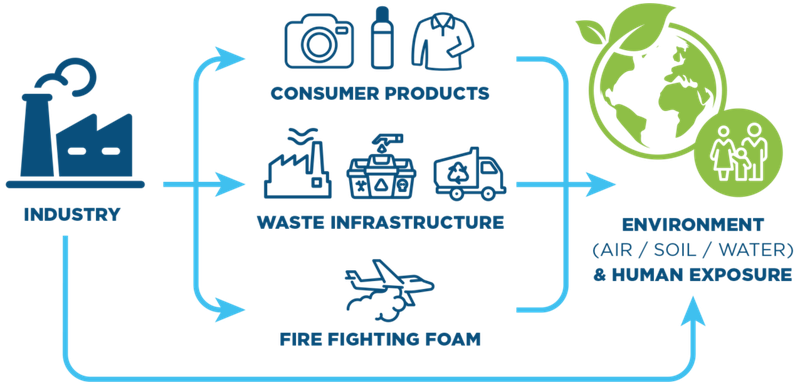
New York recently adopted the first-in-the-nation drinking water standard for 1,4-Dioxane, establishing a maximum contaminant level (MCL) of 1 part per billion (ppb). In addition, New York announced MCLs for Perfluorooctanoic acid (PFOA) and Perfluorooctane sulfonate (PFOS) at 10 parts per trillion (ppt). New Jersey also recently adopted MCLs for PFOA at 14 ppt and PFOS at 13 ppt.
Here is more detailed information regarding these emerging contaminants:
WHAT IS PFAS?
Per- and Polyfluoroalkyl Substances (PFAS) are a group of manufactured chemicals that are found in a wide variety of consumer and industry products including: non-stick cookware, waterproof and stain proof coatings, firefighting foam, and drinking water. PFAS have strong chemical bonds that make them resistant to degradation in the environment. There is evidence that these chemicals can have adverse health effects which is why they are contaminants of emerging concern.

It is estimated that there are 5,000 different types of PFAS, but some have been more widely used than others. The most extensively used and studied are PFOA and PFOS.
WHAT IS 1,4-DIOXANE?
1,4-Dioxane is a synthetic industrial chemical that has been used as a stabilizer in solvents, paint strippers, greases, and wax. Below are examples of products that can contain 1,4-Dioxane:

This chemical is likely a human carcinogen and has been found in groundwater throughout the United States. For more information regarding the health effects see Walden’s Blog: How will the 1,4-Dioxane in my Drinking Water Affect my Health?
WHAT IS NEW YORK REGULATING?
New York’s recently adopted drinking water MCLs for 1,4-Dioxane, PFOA and PFOS mean that public water systems in the state are required to perform regular testing and monitoring for these chemicals. In areas where drinking water is threatened by these emerging contaminants, treatment will be required to meet the MCLs. The new drinking water standards will be effective immediately upon publication of a Notice of Adoption in the New York Register.
New York State has been progressive in developing regulations on 1,4-Dioxane. At the end of 2019, Governor Cuomo signed legislation that will prohibit the sale of household cleaning products containing 1,4-Dioxane and limits the sale of cosmetic and personal care products with certain levels of 1,4-Dioxane. This law takes effect on January 1, 2022.
WHAT IS NEW JERSEY REGULATING?
In 2018, New Jersey was the first state to establish an MCL for a PFAS compound, setting the limit for PFNA at 13 ppt. In June 2020, NJ also established enforceable MCLs for PFOA (14 ppt) and PFOS (13 ppt). New Jersey has yet to adopt an MCL for 1,4-Dioxane, but the New Jersey Drinking Water Quality Institute is currently developing an MCL recommendation for 1,4-Dioxane.
WHAT OTHER STATES ARE REGULATING PFAS?
The EPA has been working with states to address PFAS issues, but the federal government has yet to release any MCLs. This has led many states to adopt or propose their own limits. States that have adopted limits to date include: Michigan, New Hampshire, New Jersey, New York, and Vermont.
Michigan adopted MCLs for PFNA (6 ppt), PFOA (8 ppt), PFHxA (400,000 ppt), PFOS (16 ppt), PFHxS (51 ppt), PFBS (420 ppt), and HFPO-DA (370 ppt). New Hampshire adopted MCLs for PFOA (12 ppt), PFOS (15 ppt), PFHxS (18 ppt), and PFNA (11ppt). Vermont adopted an MCL for the sum of PFHxS, PFHpA, PFNA, PFOS, and PFOA of 20 ppt. As you can see, in the absence of EPA standards for PFAS, the individual PFAS compounds regulated and the associated drinking water standards vary from state to state.
See Walden’s other blog on PFAS: Regulatory Update: EPA Announces Plan to Deal with PFAS
WHAT OTHER STATES ARE REGULATING 1,4-DIOXANE?
New York is the first state with an adopted MCL for 1,4-Dioxane. Other states are setting advisory limits, but have not adopted MCLs.
For information on 1,4-Dioxane on Long Island:
The Origins of 1,4-Dioxane: How Did It Get Into Long Island’s Drinking Water?
Update: Long Island’s 1,4-Dioxane Issue
Walden’s environmental professionals have been tracking regulatory developments related to emerging contaminants and drinking water issues. If you need assistance keeping your community’s drinking water safe, please contact Walden today!
